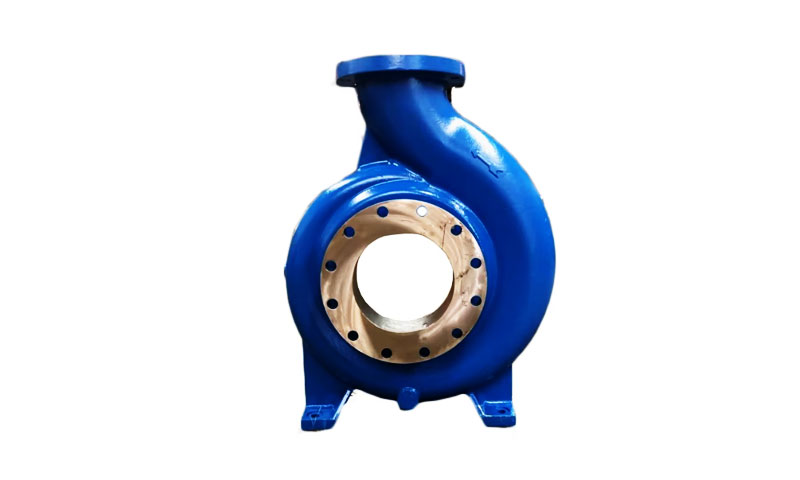1. Introducción
Pump bodies are structural and hydraulic housings that convert driver energy into fluid motion. They commonly contain volutes, impeller seats, bearing bosses, flanges and internal passages.
The manufacturing route chosen for a pump body sets achievable geometry, metalurgia, cost and lead time.
Investment casting stands out where geometry is complex (internal guide vanes, thin webs, integrated bosses), tolerances are tight, and high-integrity alloys (aceros inoxidables, aleaciones de níquel, bronce) son necesarios.
2. What Is an Investment Casting Pump Body?
Definition and core functionality
Un casting de inversión pump body is a pump housing produced by the lost-wax (inversión) método de fundición.
A wax (o polímero) pattern of the pump body is created, coated in refractory ceramic to build a shell, the wax removed by heating, and molten metal poured into the ceramic mold.
The fired shell is broken away after solidification to reveal a near-net cast pump body that is subsequently finished and inspected.
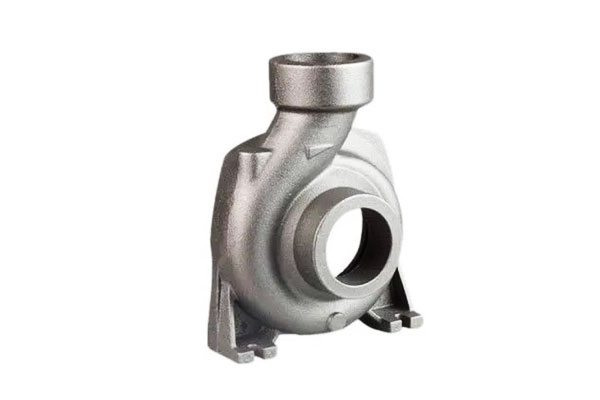
Typical specifications and dimensions
- Part mass: investment cast pump bodies usually range from a few hundred grams to tens of kilograms per piece; many foundries routinely cast pump bodies from ~0.5 kg up to ~50–100 kg depending on plant capability.
- Espesor de la pared: typical nominal walls for stainless or nickel alloys: 3–12 mm; minimum thin sections down to 1–2 mm are achievable in selected alloys and process control.
- Tolerancia dimensional (talentoso): general investment cast tolerances commonly fall in ± 0.1–0.5 mm for small features; percent-based tolerance of ±0.25–0.5% linear is a practical rule of thumb.
Critical machined features are usually left with machining allowance (0.2–2.0 mm depending on casting accuracy). - Acabado superficial (talentoso): typical Ra 1.6–3.2 μm (50–125 min) for standard ceramic shells; fine shells and careful pouring can produce Ra ≈ 0.8–1.6 μm.
Sealing faces or bearing journals are machined/lapped to much finer Ra (≤ 0.2 μm) as required.
3. Consideraciones de diseño
Investment casting enables complex geometry, but good design practice maximizes quality and minimizes cost.
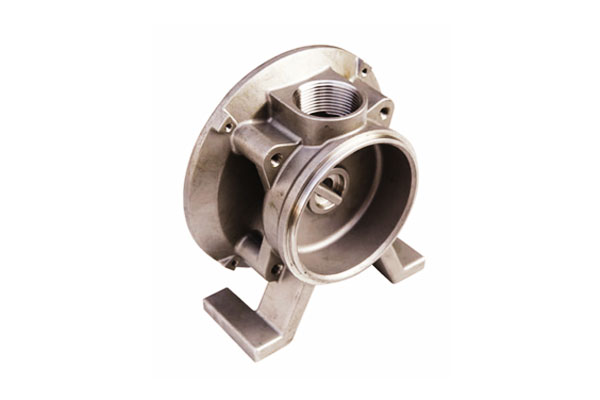
Hydraulic performance requirements
- Flow passages & volutes: smooth fillets and controlled convergence avoid separation and cavitation.
Internal fillet radii should be generous (≥ 1–2× wall thickness) to reduce turbulence. - Impeller seat alignment: concentricity and perpendicularity are critical — plan for machined bores and datum features.
- Clearances: pump clearances at impeller overhangs and seal faces must be maintainable by post-cast machining.
Structural requirements
- Stress & fatiga: consider cyclical loads; use finite-element analysis to identify local stress risers.
Cast metallurgy (tamaño de grano, segregación) affects fatigue life—design to avoid thin, highly stressed bosses without proper filleting. - Vibration: stiff webs and ribs help raise natural frequencies; investment casting allows ribs to be integrated into the body.
Corrosión & tener puesto
- Selección de material: choose alloy based on fluid chemistry (ph, cloruros, partículas erosivas, temperatura).
For seawater, duplex or cupronickel may be required; for acids, Hastelloy or appropriate nickel alloys. - Erosion resistance: smooth internal surfaces and sacrificial coatings (ruidoso, rociamiento térmico) are options where particulate slurry is present.
Tolerancias dimensionales & acabado superficial
- Características críticas: designate which faces/bores are finish-machined and specify machining allowances (P.EJ., 0.5–1.5 mm for sandier shells, 0.2–0.6 mm for precision shells).
- Sealing surfaces: specify Ra and flatness; often lapped/polished to Ra ≤ 0.2 μm and flatness within 0.01–0.05 mm depending on pressure class.
4. Materials for Investment Casting Pump Bodies
Material selection is a critical factor in designing and producing investment-cast pump bodies, as it directly affects mechanical performance, resistencia a la corrosión, fabricación, y vida útil.
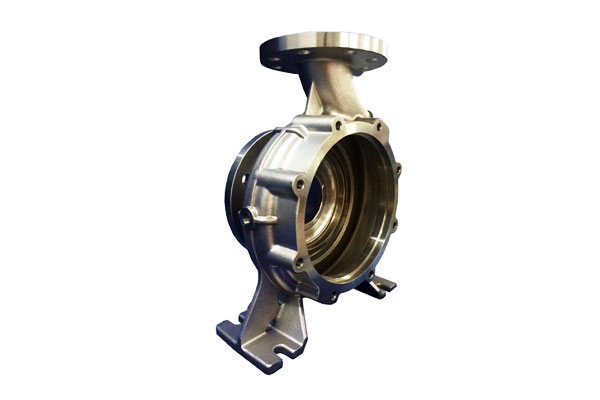
| Categoría de material | Aleaciones de ejemplo | Propiedades clave | Aplicaciones típicas | Consideraciones de casting |
| Austenítico Acero inoxidable | 304, 316L | Excelente resistencia a la corrosión, fuerza moderada, buena soldadura; De tensión: 480–620 MPA, Producir: 170–300 MPA, Alargamiento: 40–60% | General chemical pumps, tratamiento de agua, alimento & bebida | Good molten fluidity, low hot-cracking risk, easy post-machining |
| Acero inoxidable dúplex | 2205, 2507 | Alta fuerza (Yield 450–550 MPa), superior chloride stress corrosion resistance | Marine and offshore pumps, ambientes químicos agresivos | Requires controlled temperature; post-casting heat treatment to prevent sigma phase |
Aleaciones de níquel |
Incomparar 625, 718; Hastelloy | Resistencia de corrosión excepcional, fuerza de alta temperatura, resistencia a la oxidación | Procesamiento químico, generación de energía, aceite & gas | High melting points (≈1450–1600 °C); careful mold preheating and controlled pouring needed; difficult machining |
| Bronce and Copper Alloys | C93200, C95400 | Excelente resistencia a la corrosión del agua de mar, buena resistencia al desgaste, antifouling; lower mechanical strength | Bombas marinas, enfriamiento de agua de mar, componentes hidráulicos | Lower melting points (≈1050–1150 °C) simplify casting; low thermal cracking risk; mechanical strength lower than stainless/nickel |
5. Investment Casting Process for Pump Bodies
Fundición a la cera perdida, también conocido como Casting de cera perdido, enables the production of pump bodies with complex geometries, paredes delgadas, y alta precisión dimensional.
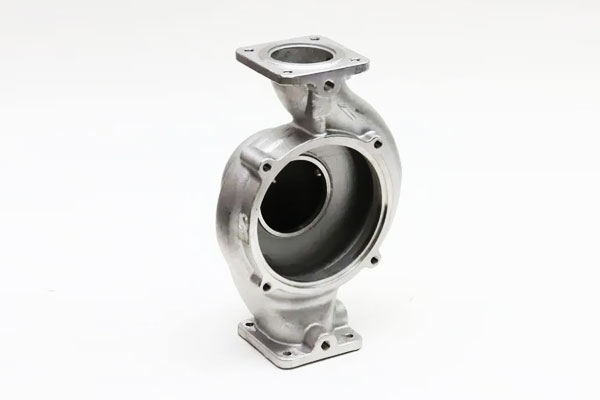
The process consists of several critical steps:
| Paso | Descripción | Consideraciones clave |
| 1. Creación de patrones de cera | Molten wax is injected into precision molds to form replicas of the pump body. | Ensure uniform wall thickness; maintain dimensional accuracy ±0.1 mm; use high-quality wax to prevent distortion. |
| 2. Assembly of Wax Tree | Individual wax patterns are attached to a central wax sprue to form a tree for batch casting. | Sprue design affects metal flow; minimize turbulence during pouring. |
| 3. Edificio de conchas de cerámica | Repeated dipping in ceramic slurry and stuccoing with fine refractory sand creates a strong, caparazón resistente al calor. | Target shell thickness (5–10 mm) depends on pump body size; avoid cracks and porosity in the shell. |
| 4. Dewaxing and Mold Firing | Wax is melted out (autoclave or kiln), Dejando una cavidad; the ceramic shell is then fired to remove residues and strengthen the mold. | Temperature ramping must be controlled to prevent shell cracking; residual wax must be fully removed. |
5. Vertido de metal |
Metal fundido (acero inoxidable, nickel alloy, o bronce) is poured into the preheated ceramic mold under gravity or vacuum-assisted conditions. | Pouring temperature and rate must ensure complete filling; control turbulence and prevent oxide formation. |
| 6. Solidificación y enfriamiento | Metal solidifies inside the mold; cooling rates affect microstructure, propiedades mecánicas, y estrés residual. | Thick sections may require controlled cooling to prevent porosity; thin walls must avoid hot tearing. |
| 7. Eliminación de concha | Ceramic shell is broken away mechanically, often using vibration, sand blasting, or chemical dissolution. | Avoid damaging intricate pump channels or flanges. |
| 8. Finishing and Cleaning | Residual ceramic, gating system, and surface imperfections are removed via grinding, disparo, or chemical cleaning. | Maintain dimensional tolerances; prepare surfaces for subsequent machining or coating. |
6. Operaciones posteriores a la clasificación
After the pump body is removed from the ceramic shell, several post-casting operations are performed to ensure the component meets functional, dimensional, y requisitos de calidad de la superficie.
These operations are critical for high-performance applications in chemical, marina, y sectores industriales.
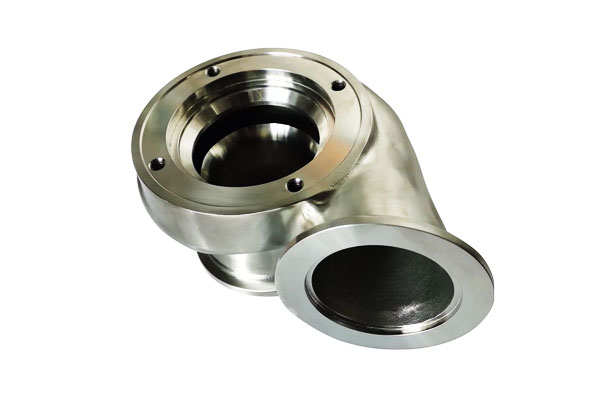
Tratamiento térmico
Tratamiento térmico is applied to relieve residual stresses, Mejorar la ductilidad, and optimize mechanical properties:
- Recocido para alivio del estrés: Heating to 550–650 °C for stainless steels reduces residual stress from casting and prevents distortion during machining.
- Recocido de solución: Applied for stainless steels and nickel alloys to homogenize microstructure and dissolve unwanted precipitates, ensuring corrosion resistance and consistent hardness.
- Aging or Precipitation Hardening (for certain alloys): Enhances strength and wear resistance in high-performance materials.
Mecanizado
Critical dimensions such as flanges, orientación, mating surfaces, and threaded ports are machined to meet tight tolerances.
Typical machining operations include turning, molienda, perforación, and boring. Machining ensures:
- Dimensional tolerances of ±0.05–0.1 mm for precise assembly.
- Smooth sealing surfaces to prevent leaks in high-pressure applications.
Acabado superficial
Acabado superficial Mejora la resistencia a la corrosión, resistencia al desgaste, y estética:
- Pulido: Improves smoothness for sealing faces and internal channels.
- Disparo: Removes residual ceramic particles and creates a uniform surface for coating or painting.
- Revestimiento: Optional chemical or electroplated coatings (P.EJ., níquel, Ptfe) enhance corrosion resistance and reduce friction.
Pruebas no destructivas (NDT)
To detect defects such as porosity, grietas, or inclusions, NDT is performed:
- Radiografía (radiografía): Identifies internal voids and inclusions.
- Prueba ultrasónica (Utah): Detects subsurface flaws in thick sections.
- Prueba de penetrante de tinte (PT): Reveals surface cracks and porosity.
Cleaning and Inspection
Finalmente, pump bodies are cleaned to remove residual machining oils, Escombros, or salts. Dimensional and visual inspections verify compliance with specifications before assembly or shipment.
7. Quality Assurance and Testing
Seguro de calidad (QA) is critical in ensuring that investment casting pump bodies meet design specifications, performance standards, y requisitos de la industria.
A systematic QA approach combines dimensional checks, prueba mecánica, and non-destructive evaluation to detect defects and confirm functional integrity.
Inspección dimensional
Dimensional verification ensures that the pump body conforms to design drawings and tolerances:
- Coordinar máquinas de medición (Cmm): Measure complex geometries, orientación, bridas, and mounting surfaces with accuracy of ±0.01–0.05 mm.
- Gauge Tools: Thread gauges, plug gauges, and height gauges verify critical features quickly in production.
- Medición de rugosidad de la superficie: Confirms finishing requirements for sealing faces and internal channels (P.EJ., Ra ≤0.8 μm for hydraulic components).
Mechanical Property Verification
Mechanical testing validates that the material meets required strength, ductilidad, y dureza:
- Prueba de tracción: Measures yield strength, ultimate tensile strength, y alargamiento, ensuring the material can withstand operational loads.
- Prueba de dureza: Rockwell or Vickers testing confirms that heat treatment and material processing achieved the desired hardness.
- Prueba de impacto (si es necesario): Evaluates toughness for applications exposed to fluctuating loads or shock.
Pruebas no destructivas (NDT)
NDT techniques detect hidden defects without damaging the part:
- Radiografía (X-ray/CT Scanning): Identifies internal porosity, inclusiones, and voids, particularly in thick sections.
- Prueba ultrasónica (Utah): Detects internal cracks, vacío, or delaminations in dense materials like stainless steel and nickel alloys.
- Prueba de penetrante de tinte (PT): Reveals surface cracks, agujeros, or fine porosity not visible to the naked eye.
- Prueba de partículas magnéticas (MONTE): Applied for ferromagnetic alloys to detect surface and near-surface discontinuities.
Common Casting Defects and Mitigation Strategies
- Porosidad: Minimized through proper gating, desfogue, and controlled solidification rates.
- Cavidades de contracción: Addressed via riser design and thermal management.
- El frío se cierra y se queda maltratados: Avoided by maintaining optimal pouring temperatures and smooth flow in complex geometries.
- Surface Inclusions: Controlled by using high-purity alloys and proper degassing techniques.
8. Advantages of Investment Casting for Pump Bodies
- Geometría compleja: pasajes internos, thin walls and integrated bosses with minimal secondary assembly.
- Forma cercana a la red: reduces material removal vs. rough machining from bar or billet — often 30–70% less machining para piezas complejas.
- Alta precisión dimensional & acabado superficial: less secondary finishing for many features compared with sand casting.
- Alloy flexibility: cast many stainless and nickel alloys with good metallurgical integrity.
- Small to medium production flexibility: tooling for wax patterns is relatively inexpensive vs. large die tooling, enabling economic runs from prototypes to thousands of parts.
9. Limitaciones y desafíos
- Cost for very large parts: above certain sizes (a menudo >100 kg) investment casting becomes uneconomical compared with sand casting or fabricating/ welding.
- Tiempo de entrega: pattern tooling, shell building and firing add lead time—prototype timelines usually measured in weeks.
- Porosity risk in thick sections: thick bosses or large cross-sections require careful gating, chills or segmenting to avoid shrinkage.
- Surface finish and tolerances depend on shell system: achieving ultra-fine finishes or extremely tight as-cast tolerances requires premium ceramic systems and process control.
10. Aplicaciones industriales
Investment casting pump bodies are used across a broad spectrum of industries due to their complex geometry capabilities, versatilidad del material, y alta precisión dimensional.
The process allows engineers to design optimized hydraulic passages, paredes delgadas, and integrated mounting features that improve pump efficiency and longevity.
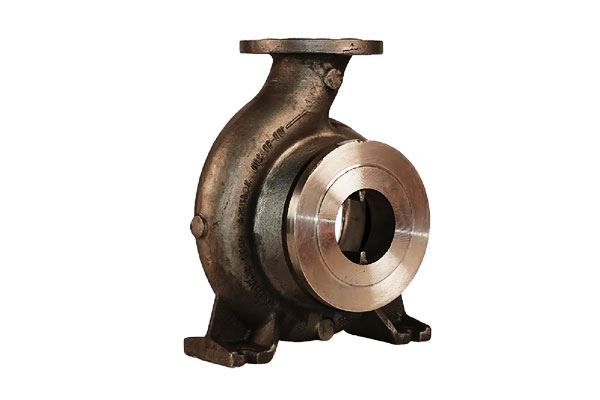
Chemical Processing Pumps
- Ambiente: Corrosive fluids such as acids, caustics, y solventes.
- Materials Used: Aceros inoxidables (316L, dúplex) and nickel alloys (Hastelloy, Incomparar).
- Razón fundamental: Investment casting enables intricate internal channels, minimizing turbulence and ensuring uniform flow, critical for chemical process reliability.
Water and Wastewater Pumps
- Ambiente: High-volume pumping, abrasive suspended solids, and variable pH levels.
- Materials Used: Bronce, acero inoxidable dúplex, and corrosion-resistant cast irons.
- Razón fundamental: Thin-wall, smooth internal passages reduce clogging and energy losses, improving efficiency in municipal and industrial water systems.
Marine and Offshore Pumps
- Ambiente: Saltwater exposure, high-pressure operation, and cyclical mechanical stress.
- Materials Used: Aleaciones de cobre (latón naval, bronce), aceros inoxidables dúplex.
- Razón fundamental: Resistance to corrosion and biofouling is critical; investment casting allows seamless, complex geometries to reduce maintenance and improve service life.
Aceite & Gas and Power Generation Pumps
- Ambiente: A alta temperatura, high-pressure fluids, and hydrocarbon-based media.
- Materials Used: High-nickel alloys (Incomparar, Hastelloy), acero inoxidable, and cobalt-based alloys.
- Razón fundamental: Investment casting supports high-strength materials and precise tolerances necessary for critical applications such as turbine lubrication, chemical injection, and offshore drilling.
Specialty and Custom Pumps
- Ambiente: Laboratory, farmacéutico, or food processing applications requiring hygienic and precision performance.
- Materials Used: Acero inoxidable (304, 316L), titanio, o aleaciones de níquel.
- Razón fundamental: Superficies suaves, tolerancias apretadas, and complex geometries achieved by investment casting ensure minimal contamination risk and compliance with regulatory standards.
11. Análisis comparativo
| Característica / Criterios | Casting de inversión | Fundición de arena | Machining from Solid |
| Complejidad geométrica | Excellent – thin walls, canales internos, intricate features achievable | Moderate – limited by core placement and mold stability | Limited – complex internal geometries often impossible without assembly |
| Precisión dimensional | High – ±0.1–0.25 mm typical | Moderate – ±0.5–1.0 mm | Very High – ±0.05 mm achievable |
| Acabado superficial (Real academia de bellas artes) | Fine – 1.6–3.2 μm typical; can be polished | Rough – 6–12 μm; requires machining for precision | Excellent – 0.8–1.6 μm achievable with finishing |
| Opciones de material | Wide – stainless steels, aleaciones de níquel, bronce, aleaciones de cobre | Wide – iron, acero, bronce, aluminio | Wide – depends on machinable stock availability |
| Tamaño por lotes | Low-to-medium – 1–1000+ parts | Medium-to-high – economical for large, piezas simples | Low – material waste increases cost for large parts |
| Tiempo de entrega | Moderate – wax pattern & shell building required | Short-to-moderate – mold preparation relatively quick | Variable – depends on machining complexity |
Desechos materiales |
Low – near-net shape reduces scrap | Moderate – gating and risers generate some waste | High – subtractive process creates chips and offcuts |
| Costo por parte | Moderate-to-high – tooling and process steps increase cost, economical for complex parts | Low-to-moderate – simpler molds, larger parts cheaper | High – extensive machining on large, complex parts is expensive |
| Fortaleza & Integridad | Excellent – dense microstructure, minimal porosity if controlled | Moderate – risk of sand-related inclusions and porosity | Excellent – homogeneous, Sin defectos de casting |
| Post-Processing Required | Often minimal – some machining, refinamiento | Usually significant – machining and finishing required | Minimal – final finishing for tight tolerances only |
| Aplicaciones típicas | Pump bodies with thin walls, complex hydraulic channels, resistencia a la corrosión | Grande, simple pump housings or structural components | Custom or prototype pump bodies requiring extreme precision |
12. Conclusión
Investment casting pump body combines design freedom with metallurgical integrity, making them an excellent choice for many fluid-handling applications—especially where complex internal geometry, exotic alloys or tight tolerances are required.
Success depends on early design for casting, informed material selection, careful process control (torrencial, shelling, tratamiento térmico), and robust QA/NDT programs.
For critical pump systems—marine, chemical or power generation—investment casting can deliver reliable, economical components when specified and executed correctly.
Preguntas frecuentes
What maximum size of pump body can be investment cast?
Typical shop practice ranges up to ~50–100 kg per part, but the practical maximum depends on foundry capability and economics.
Very large pump bodies are more often produced by sand casting or fabricating/welding.
How much machining allowance should I design into an investment casting?
Permitir 0.2–2.0 mm depending on the criticality and shell precision. Specify tighter allowances only where the foundry guarantees precision shells.
Which material is best for seawater pump bodies?
Duplex stainless steels and selected copper-nickel alloys are common choices due to superior chloride pitting resistance and biofouling performance; final selection depends on temperature, velocity and erosion conditions.
What is the typical turnaround time for an investment-cast pump body?
Small production runs typically take 4–8 semanas from pattern approval to finished parts; single prototypes can be faster with 3D-printed patterns but still require shell firing and melt schedules.
How do I specify acceptance criteria for porosity?
Use industry NDT standards (radiografía, Connecticut, Utah) and define acceptance levels in percent porosity by volume or via reference images.
Critical pressure-retaining pump bodies often require porosity <0.5% by volume and radiographic acceptance per customer standard.
